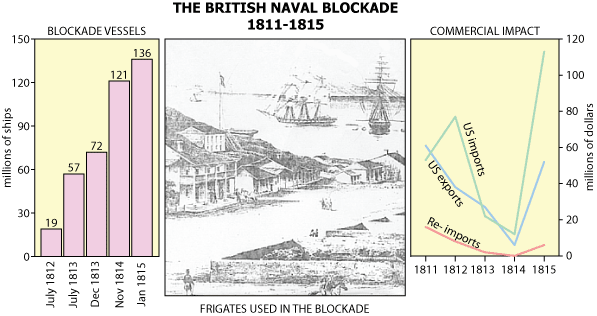|
|
||||||
 |
British Naval Blockade, 1811-1815 |
The British blockade, loosely enforced in the north until Feb. 1813, left New England open to 'licence' neutral commerce. By 1814, the blockade was extended from Narranganett Bay to Spanish Florida. Meanwhile, the United States dotted the seas with privateers, its only effective response to the blockade. The eighteen naval sea-fights were single-ship actions of little consequence to the outcome of the war, but they did dispose the British towards a more liberal peace. The object of the naval blockade was the destruction of commerce. This was effected not by fighting but by having enough naval vessels patrolling off-shore to intercept all outgoing or incoming commercial vessels, Naval records in the National Maritime Museum, Greenwich, England, estimate the numbers of British blockading vessels patrolling the American coast from 1812 to 1815 to be as follows: July 1812, 23; July 1813, 57; Dec 1813, 72; Nov 1814, 121; Jan 1815, 136. The War of 1812 saw the final flourish of privateering. This was the practice of outfitting commercial vessels with guns and enlarged crews and then sending them off to prey on enemy commercial vessels on the high seas; privately owned vessels became, in effect, an auxiliary navy. There were unknown hundreds of American privateers as well as unofficial pirates roaming the oceans throughout the War of 1812. The Maritime provinces armed 47 privateers, which made 207 recorded captures. |
Data Files (.xls)
British_Naval_Blockade_1811_1815.xls |